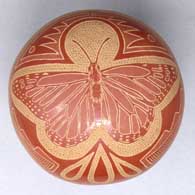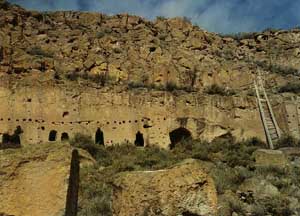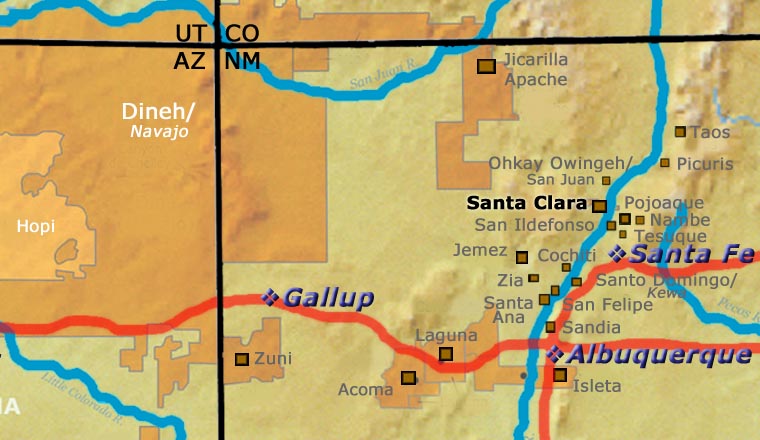
Rosemary Apple Blossom
Lonewolf
Santa Clara
Born into Santa Clara Pueblo in 1954, Rosemary "Apple Blossom" Lonewolf is the daughter of Joseph Lonewolf. Greg Lonewolf is her brother, Susan Romero her sister. She grew up in a pottery making household and was exposed to every aspect of it along the way. Rosemary was active in the marketplace right out of high school, after learning how to make pottery the traditional way from her father and how to decorate her pots using the sgraffito technique, beginning in 1972. She mostly makes miniatures and sgraffito seed pots.
Rosemary's tribal affiliation is Santa Clara but she grew up mostly in Colorado Springs, Colorado. She attended Fort Lewis College in Durango, Colorado, then Arizona State University in Tempe, Arizona.
Since beginning her career as a potter, she has won acclaim in both Native American and non-Native art exhibits. She spent some time as an artist-in-residence at Harvard University and at the Heard Museum. She even designed a couple pedestrian bridges crossing highways in Tucson and Phoenix.
Rosemary's work has been featured at the Smithsonian Institute, the National Museum of American History, the Heard Museum and the New Mexico Museum of Indian Arts and Culture, among others. She has also been recognized by the Arizona Commission on the Arts.
While Rosemary is most known for her sgraffito work, she has also created some major ceramic installations, including a 30-foot ceramic-and-glass art fence at the Heard Museum in 2006, in collaboration with Tony Jojola of Isleta Pueblo. That year she and Tony were Signature Artists during the annual Indian Arts Fair & Market.
Some Exhibits that Featured Rosemary's Work
- Choices and Change: American Indian Artists in the Southwest. Heard Museum North. Scottsdale, AZ. June 30, 2007 - April 30, 2014
- Home: Native People in the Southwest. Heard Museum. Phoenix, AZ. 2005
- Breaking the Surface: Carved Pottery Techniques and Designs. Heard Museum. Phoenix, AZ. October 2004 - October 2005
- Every Picture Tells a Story. Heard Museum. Phoenix, AZ. 2002 - 2005
- Public Sculpture. Heard Museum. Phoenix, AZ. 2001- 2002
- Heard Museum Artist in Residence. Heard Museum. Phoenix, AZ. June 1, 2000 - July 31, 2000
- Untold Stories: Celebrating Community and Culture. Grady Gammage Auditorium, Arizona State University. Tempe, AZ. April 2, 1999 - May 2, 1999
- Diversity in Expression: Arizona Women Artists. Tucson Pima Arts Council Community Gallery. Tucson, AZ. May 3, 1999 - June 4, 1999
- Head+Heart+Hands: Native American Craft Traditions in a Contemporary World. 1998-2000 Traveling exhibit planned for the following venues: Kentucky Art and Craft Gallery, Louisville, KY, 8/21-10/31/1998; Ohio Craft Museum, Columbus, OH, 11/22/1998-01/21/1999; Yakama Nation Cultural Heritage Center and Museum, Yakima, WA, 5/15-7/17/1999; DeLand Museum, Deland, FL, 10/29/1999-1/2/2000. August 21, 1998 - January 2, 2000
- The Southwest Indian Art Show. Mesa Convention & Community Center. Mesa, AZ. November 14, 1998 - November 15, 1998
- Generations. Galeria Mesa. Mesa, AZ. October 13, 1998 - November 14, 1998
- Expressions of Spirit: Contemporary American Indian Art. Wheelwright Museum. Santa Fe, NM. February 4, 1995 - May 10, 1995
- Art of the Southwest. October Art Gallery. New York, NY. February 7, 1992 - February 21, 1992
- Magic in Clay. Morrill Hall, University of Nebraska State Museum. Lincoln, NE. May 5, 1991 - August 30, 1991
- The Absolute Best of Indian Market. Gallery 10. Four Seasons Hotel. Los Angeles, CA. November 18, 1989 - November 19, 1989
- New Works by Dora, Russell, Rosemary, Polly Rose & Jacquie. Gallery 10. Scottsdale, AZ. March 16, 1989 - March 22, 1989
- Clay and Steel. Gallery 10. Scottsdale, AZ. March 3, 1988 - March 30, 1988
- Native American Group Exhibition. Elaine Horwitch Galleries. Santa Fe, NM. August 15, 1986 - August 27, 1986
- Masters of Sgraffito Pottery. Andrews Gallery Old Town. Albuquerque, NM. June 21, 1986 - July 15, 1986
- Special Anniversary Show. Pueblo Vista Gallery II. San Diego, CA. May 24, 1986 - June 15, 1986
- Contemporary Southwest Indian Pottery. Sid Deutsch Gallery. New York, New York. November 30, 1985 - December 31, 1985
- Jewels of the Desert: Works of Contemporary Southwestern Artists. Art Institute of Philadelphia. Philadelphia, Pennsylvania. June 13-21, 1985
- Clay, Canvas, Threads and Thrills: The Best of the Southwest. Robillard Galleries and Colorado Opera Festival. Central City, Colorado. May 22-28, 1983
- Camilio Tafoya, Rosemary Apple Blossom Speckled Rock, Joseph Lonewolf, Grace Medicine Flower. Governor's Gallery, State Capitol. Santa Fe, New Mexico. November 7, 1977 - December 9, 1977
- Joseph Lonewolf, Camilio Sunflower Tafoya, Apple Blossom and Paul Speckled Rock. The Eagle Dancer. Sedona, Arizona. October 19-30, 1974
100 West San Francisco Street, Santa Fe, New Mexico 87501
(505) 986-1234 - www.andreafisherpottery.com - All Rights Reserved

Santa Clara Pueblo

Ruins at Puye Cliffs, Santa Clara Pueblo
Santa Clara Pueblo straddles the Rio Grande about 25 miles north of Santa Fe. Of all the pueblos, Santa Clara has the largest number of potters.
The ancestral roots of the Santa Clara people have been traced to ancient pueblos in the Mesa Verde region in southwestern Colorado. When that area began to get dry between about 1100 and 1300 CE, some of the people migrated eastward, then south into the Chama River Valley where they constructed several pueblos over the years. One was Poshuouinge, built about 3 miles south of what is now Abiquiu on the edge of the Jemez foothills above the Chama River. Eventually reaching two and three stories high, and with up to 700 rooms on the ground floor, Poshuouinge was occupied from about 1375 CE to about 1475. Drought then again forced the people to move, some of them going to the area of Puye (on the eastern slopes of the Pajarito Plateau of the Jemez Mountains) and others downstream to Ohkay Owingeh (San Juan Pueblo, along the Rio Grande). Beginning around 1580 CE, drought forced the residents of the Puye area to relocate closer to the Rio Grande and they founded what we now know as Santa Clara Pueblo on the west bank of the river, with San Juan Pueblo to the north and San Ildefonso Pueblo to the south.
In 1598 the seat of Spanish government was established at Yunque, near San Juan Pueblo. The Spanish proceeded to antagonize the Puebloans so badly that that government was moved to Santa Fe in 1610, for their own safety.
Spanish colonists brought the first missionaries to Santa Clara in 1598. Among the many things they forced on the people, those missionaries forced the construction of the first mission church around 1622. However, like the other pueblos, the Santa Clarans chafed under the weight of Spanish rule. As a result, they were in the forefront of the Pueblo Revolt of 1680. One Santa Clara resident, a mixed black and Tewa man named Domingo Naranjo, was one of the rebellion's ringleaders. However, the pueblo unity that allowed them to chase the Spanish out fell apart shortly after their success, especially after Popé died.
When Don Diego de Vargas came back to the area in 1694, he found most of the Santa Clarans on top of nearby Black Mesa (with the people of San Ildefonso). A six-month siege didn't subdue them so finally, the two sides negotiated a treaty and the people returned to their pueblos. However, successive invasions and occupations by northern Europeans took their toll on all the tribes over the next 250 years. Then the swine flu pandemic in 1918 almost wiped them out.
Today, Santa Clara Pueblo is home to as many as 2,600 people and they comprise probably the largest per capita number of artists of any North American tribe (estimates of the number of potters run as high as 1-in-4 residents).
Today's pottery from Santa Clara is typically either black or red. It is usually highly polished and designs might be deeply carved or etched ("sgraffito") into the pot's surface. The water serpent, (avanyu), is a very common traditional design motif on Santa Clara pottery. Another motif comes from the legend that a bear helped the people find water during a drought. The bear paw has appeared on much of their pottery ever since.
Santa Clara has received a lot of distinction because of the evolving artistry the potters have brought to their craft. Not only did this pueblo produce excellent black and redware, several notable innovations helped move pottery from the realm of utilitarian vessels into the domain of art. Different styles of polychrome redware emerged in the 1920s-1930s. In the early 1960s experiments with stone inlay, incising and double firing began. Modern potters have also extended the tradition with unusual shapes, slips and designs, illustrating what one Santa Clara potter said: "At Santa Clara, being non-traditional is the tradition." (This refers strictly to artistic expression; the method of creating pottery remains traditional).
Santa Clara Pueblo is home to a number of famous pottery families: Tafoya, Baca, Gutierrez, Naranjo, Suazo, Chavarria, Garcia, Vigil, and Tapia - to name a few.
100 West San Francisco Street, Santa Fe, New Mexico 87501
(505) 986-1234 - www.andreafisherpottery.com - All Rights Reserved


